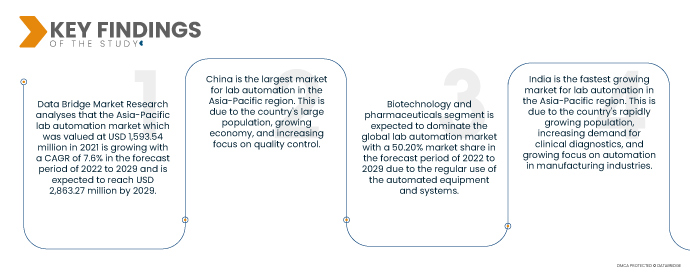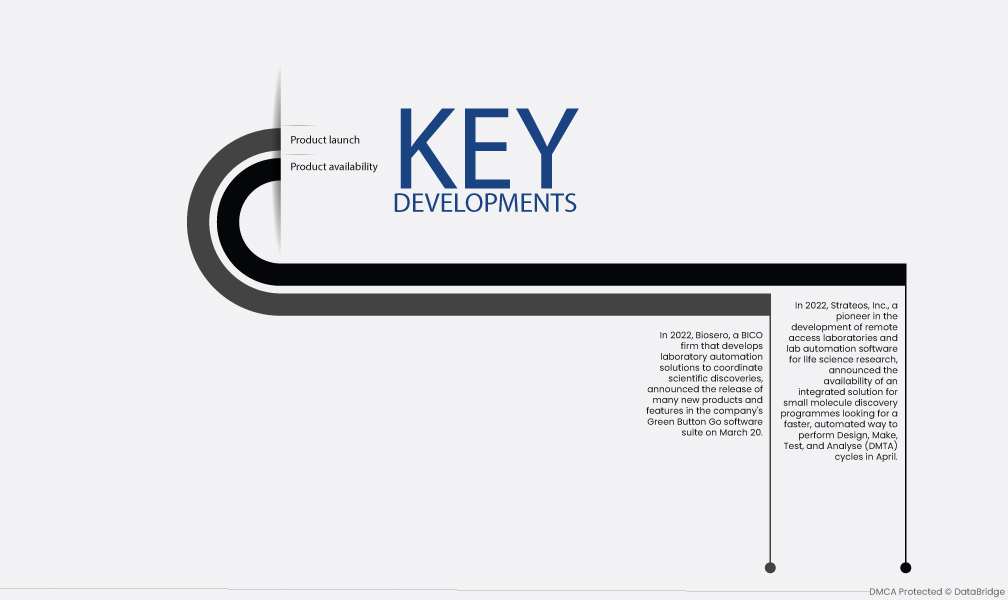Laboratory automation includes computerized lab tools and gadgets that provide numerous benefits such as increased profitability, wider work process scope, shorter time cycle, and higher information quality. Lab automation is essential for handling huge numbers of sample testing in a short period of time. For example, automated liquid handlers are frequently used in lab automation because they substantially save processing time and eliminate the possibility of sample contamination by dispensing dead amounts very efficiently. Liquid handlers use a software-based integrated system to customize handling operations with high transfer volumes.
Access Full Report at https://www.databridgemarketresearch.com/reports/asia-pacific-lab-automation-market
Data Bridge Market Research analyses that the Asia-Pacific Lab Automation Market which was valued at USD 1,593.54 million in 2021 is growing with a CAGR of 7.6% in the forecast period of 2022 to 2029 and is expected to reach USD 2,863.27 million by 2029. The expanding global demand for healthcare has increased rivalry among prominent healthcare and pharmaceutical corporations to improve lab automation. This has resulted in greater use of laboratory equipment, analyzers, and software. Market participants are working on providing a diverse set of tools, equipment, machines, and processes to aid in the development and production of automated laboratory infrastructure. Companies are making considerable expenditures and getting financing to develop sophisticated technology and procedures for lab automation in order to achieve this.
Growing demand for clinical diagnostics is expected to drive the market's growth rate
The Asia-Pacific region is home to a rapidly growing population, and this is leading to an increase in the demand for clinical diagnostics. Lab automation can help to improve the efficiency and accuracy of clinical diagnostics, and this is driving the demand for lab automation in the region. The Asia-Pacific region is home to a number of rapidly growing research and development (R&D) centers, and these centers are increasingly adopting lab automation. Lab automation can help to improve the efficiency and productivity of R&D labs, and this is driving the demand for lab automation in the region.
Report Scope and Market Segmentation
|
Report Metric
|
Details
|
|
Forecast Period
|
2022 to 2029
|
|
Base Year
|
2021
|
|
Historic Years
|
2020 (Customizable to 2014- 2019)
|
|
Quantitative Units
|
Revenue in USD Million, Volumes in Units, Pricing in USD
|
|
Segments Covered
|
Product Type (Equipment, Software and Informatics and Analyzer), Automation Type (Modular Automation and Total Lab automation), Application (Drug Discovery, Clinical Diagnostics, Genomics Proteomics Solutions, Bio Analysis, Protein Engineering, Lyophilization, System Biology, Analytical Chemistry and Others), End Users (Biotechnology and Pharmaceuticals, Hospitals and Laboratories, Research and Academic Institutions and Others)
|
|
Countries Covered
|
Japan, India, South Korea, Singapore, Malaysia, Australia, Thailand, Indonesia, Philippines, Rest of Asia-Pacific (APAC) in the Asia-Pacific (APAC)
|
|
Market Players Covered
|
QIAGEN (Germany), Siemens Healthcare (Germany),F. Hoffmann-La Roche Ltd (Roche) (Switzerland), Hamilton Company (U.S.), Hudson Robotics (U.S.), LabVantage Solutions Inc. (U.S.),Abbott (U.S.),BD (Becton, Dickinson and Company) (U.S.), bioMérieux (France), Aurora Biomed Inc. (Canada), Danaher (U.S.), Tecan Trading AG (Switzerland), PerkinElmer Inc. (U.S.), Fisher Scientific (U.S.), Agilent Technologies (U.S.), Azenta US Inc. (U.S.),Eppendorf SE (Germany), Labware (U.S.)
|
|
Data Points Covered in the Report
|
In addition to the market insights such as market value, growth rate, market segments, geographical coverage, market players, and market scenario, the market report curated by the Data Bridge Market Research team includes in-depth expert analysis, patient epidemiology, pipeline analysis, pricing analysis, and regulatory framework
|
Segment Analysis:
The Asia-Pacific lab automation market is segmented on the basis of product type, automated systems, application and end user.
- On the basis of product type, the Asia-Pacific lab automation market is segmented into equipment, software and informatics, and analyzer. Equipment segment is expected to dominate the market with a market share of 56.10% in the forecast period of 2022 to 2029 due to being more commonly used as they act as base things in the automated laboratories
Equipment segment is expected to dominate the product type segment of the Asia-Pacific lab automation market
Equipment segment is expected to dominate the market owing to equipment such as freezing machines, cutting and slicing machines, blanching machines, sorting and grading machines, and packaging machines. These equipment play a crucial role in ensuring efficient and high-quality processing of frozen fruit and vegetable mixes.
- On the basis of automation systems, the Asia-Pacific lab automation market is segmented into modular automation and total lab automation. The modular automation segment is expected to dominate the Asia-Pacific lab automation market with 79.88% market share. Modular automation is dominating in Asia-Pacific lab automation market because modular automation provides flexibility for hardware in the laboratory as well as permits recombination of components as per laboratory alteration compare than others.
- On the basis of application, the Asia-Pacific lab automation market is segmented into drug discovery, clinical diagnostics, genomic solutions, proteomic solutions, bio analysis, protein engineering, lyophilization, system biology, analytical chemistry, and others.
Drug discovery segment is expected to dominate the application segment of the Asia-Pacific lab automation market
Drug discovery segment is expected to dominate the Asia-Pacific lab automation market with 34.27% market share. Drug discovery is dominating in lab automation market because various type of lab automation equipment, software’s are widely used in drug discovery for practical identification of different kind of drug target.
- On the basis of end users, the Asia-Pacific lab automation market is segmented into biotechnology and pharmaceuticals, hospitals and laboratories, research and academic institutions, and others. Biotechnology and pharmaceuticals segment is expected to dominate the global lab automation market with a 50.20% market share in the forecast period of 2022 to 2029 due to the regular use of the automated equipment and systems.
Major Players
Data Bridge Market Research recognizes the following companies as the major market players: QIAGEN (Germany), Siemens Healthcare (Germany),F. Hoffmann-La Roche Ltd (Roche) (Switzerland), Hamilton Company (U.S.), Hudson Robotics (U.S.), LabVantage Solutions Inc. (U.S.),Abbott (U.S.),BD (Becton, Dickinson and Company) (U.S.), bioMérieux (France), Aurora Biomed Inc. (Canada), Danaher (U.S.), Tecan Trading AG (Switzerland), PerkinElmer Inc. (U.S.), Fisher Scientific (U.S.), Agilent Technologies (U.S.), Azenta US Inc. (U.S.),Eppendorf SE (Germany), Labware (U.S.).
Market Development
- In 2022, Strateos, Inc., a pioneer in the development of remote access laboratories and lab automation software for life science research, announced the availability of an integrated solution for small molecule discovery programmes looking for a faster, automated way to perform Design, Make, Test, and Analyse (DMTA) cycles in April.
- In 2022, Biosero, a BICO firm that develops laboratory automation solutions to coordinate scientific discoveries, announced the release of many new products and features in the company's Green Button Go software suite on March 20. These solutions provide enhanced features to assist customers in streamlining, controlling, and improving the results of their automated lab systems. Scientists can use Biosero's Green Button Go software to automate processes ranging from a single workstation to activities spanning numerous labs.
Regional Analysis
Geographically, the countries covered in the market report are Japan, India, South Korea, Singapore, Malaysia, Australia, Thailand, Indonesia, Philippines, and Rest of Asia-Pacific (APAC) in the Asia-Pacific (APAC).
As per Data Bridge Market Research analysis:
China is the dominant region in the Asia-Pacific lab automation market during the forecast period 2022-2029
China is the largest market for lab automation in the Asia-Pacific region. This is due to the country's large population, growing economy, and increasing focus on quality control.
India is estimated to be the fastest growing region in the Asia-Pacific lab automation market in the forecast period 2022-2029
India is the fastest growing market for lab automation in the Asia-Pacific region. This is due to the country's rapidly growing population, increasing demand for clinical diagnostics, and growing focus on automation in manufacturing industries.
For more detailed information about the Asia-Pacific lab automation market report, click here – https://www.databridgemarketresearch.com/reports/asia-pacific-lab-automation-market












